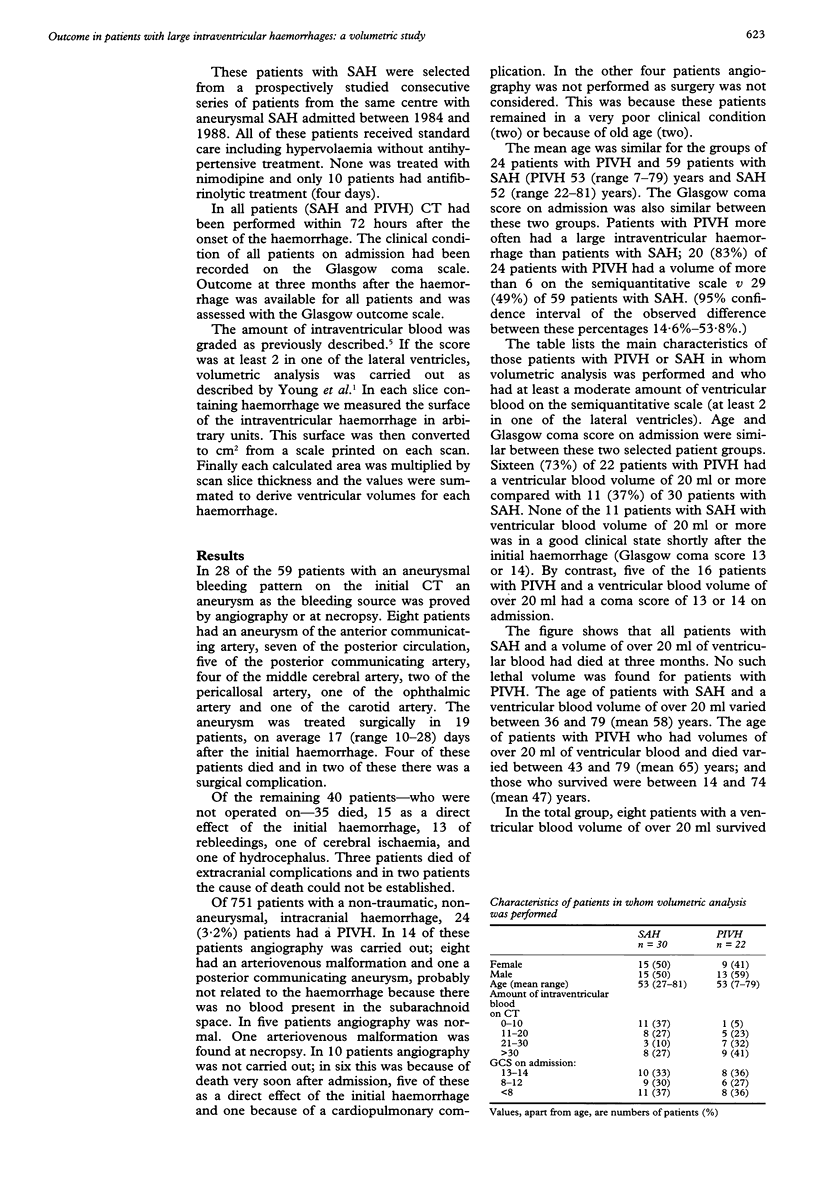Abstract
Patients with large amounts of intraventricular blood have a poor prognosis. The question is whether the quantity of ventricular blood or other factors related to the origin of the intraventricular bleeding cause poor outcome. The association between ventricular blood volume and outcome was analysed in patients with a primary intraventricular haemorrhage (PIVH) and in patients with an aneurysmal subarachnoid haemorrhage (SAH). The medical records of 24 patients with PIVH were reviewed and these patients were compared with 59 patients selected from a prospectively studied series of patients with aneurysmal SAH who had intraventricular blood without an intraparenchymal haematoma. Glasgow coma score on admission and outcome at three months expressed on the Glasgow outcome scale were available for all patients. Volumetric analysis on CT was carried out if there was at least a moderate amount of blood measured with a semi-quantitative scale (SAH n = 30, PIVH n = 22). In patients with SAH more than 20 ml intraventricular blood was lethal, as previously shown for patients with intraparenchymal haemorrhage. Patients with a PIVH can, however, survive such large volumes of intraventricular blood without impaired consciousness immediately after the bleeding, without developing hydrocephalus, and without any disability after three months. It is concluded that the cause of an intraventricular haemorrhage is more important for outcome than the amount of intraventricular blood, and large intraventricular haemorrhages are not always associated with hydrocephalus.
Full text
PDF


Selected References
These references are in PubMed. This may not be the complete list of references from this article.
- Darby D. G., Donnan G. A., Saling M. A., Walsh K. W., Bladin P. F. Primary intraventricular hemorrhage: clinical and neuropsychological findings in a prospective stroke series. Neurology. 1988 Jan;38(1):68–75. doi: 10.1212/wnl.38.1.68. [DOI] [PubMed] [Google Scholar]
- Findlay J. M., Grace M. G., Weir B. K. Treatment of intraventricular hemorrhage with tissue plasminogen activator. Neurosurgery. 1993 Jun;32(6):941–947. doi: 10.1227/00006123-199306000-00010. [DOI] [PubMed] [Google Scholar]
- Hijdra A., Brouwers P. J., Vermeulen M., van Gijn J. Grading the amount of blood on computed tomograms after subarachnoid hemorrhage. Stroke. 1990 Aug;21(8):1156–1161. doi: 10.1161/01.str.21.8.1156. [DOI] [PubMed] [Google Scholar]
- Hijdra A., van Gijn J., Nagelkerke N. J., Vermeulen M., van Crevel H. Prediction of delayed cerebral ischemia, rebleeding, and outcome after aneurysmal subarachnoid hemorrhage. Stroke. 1988 Oct;19(10):1250–1256. doi: 10.1161/01.str.19.10.1250. [DOI] [PubMed] [Google Scholar]
- Young W. B., Lee K. P., Pessin M. S., Kwan E. S., Rand W. M., Caplan L. R. Prognostic significance of ventricular blood in supratentorial hemorrhage: a volumetric study. Neurology. 1990 Apr;40(4):616–619. doi: 10.1212/wnl.40.4.616. [DOI] [PubMed] [Google Scholar]


